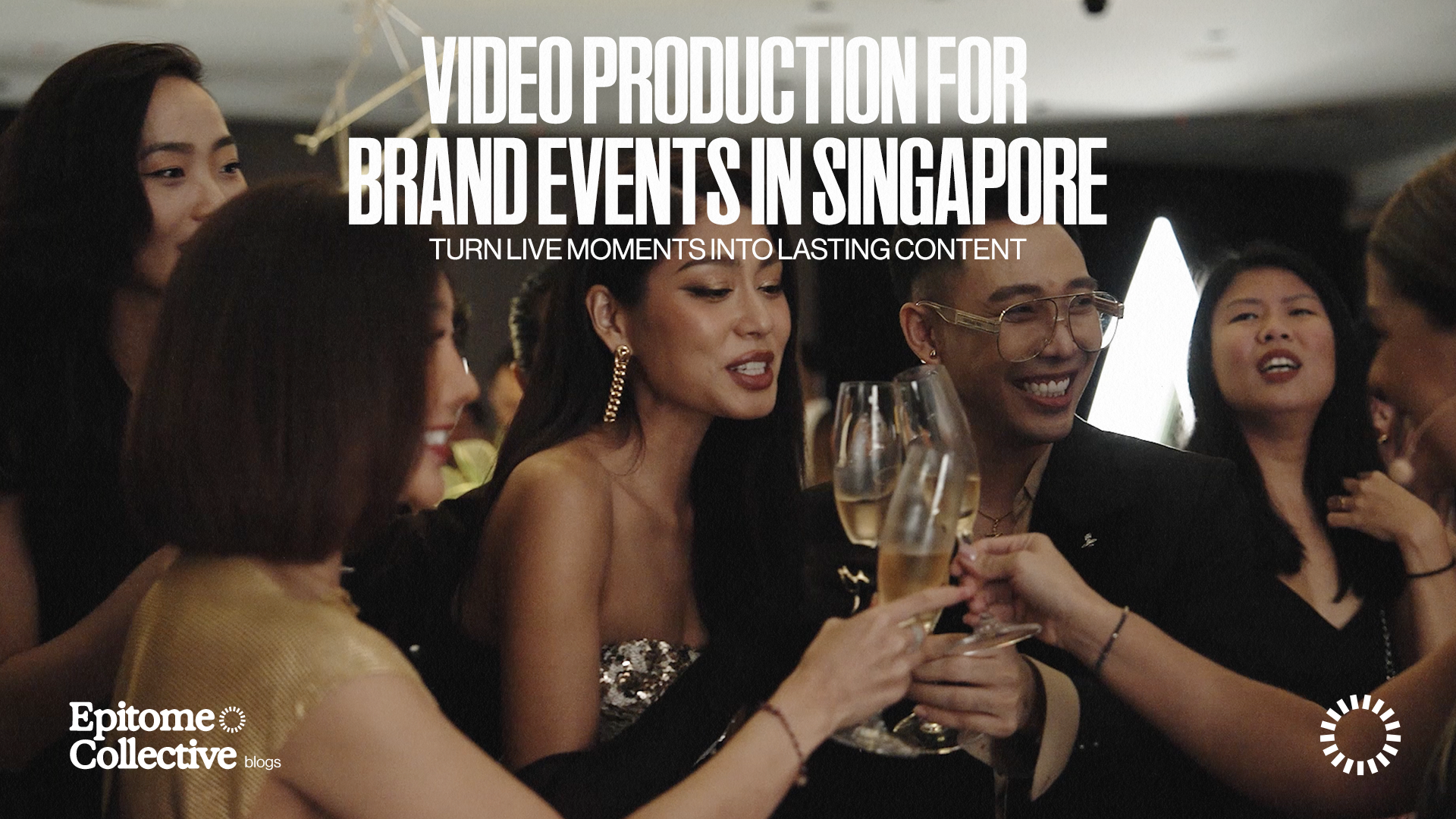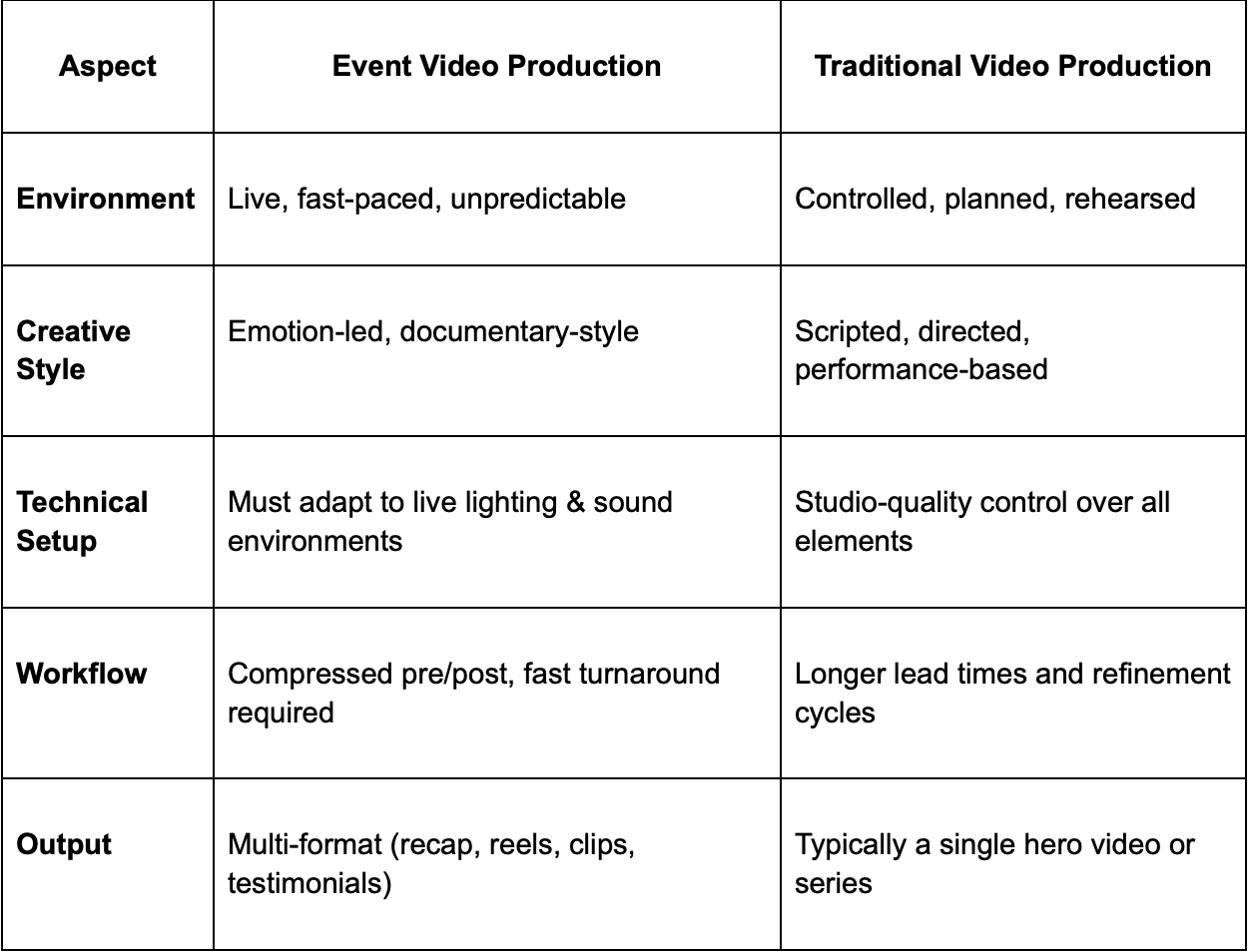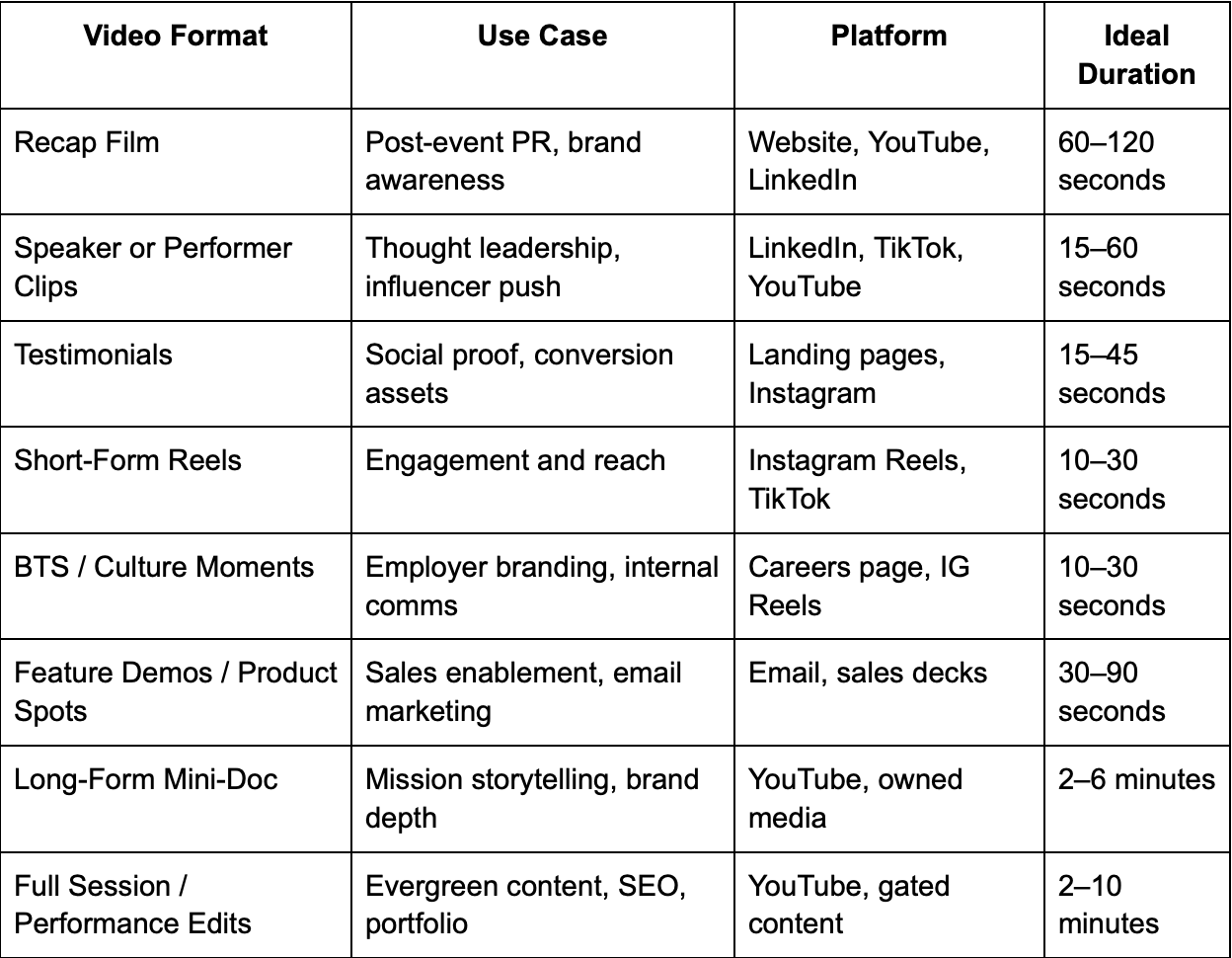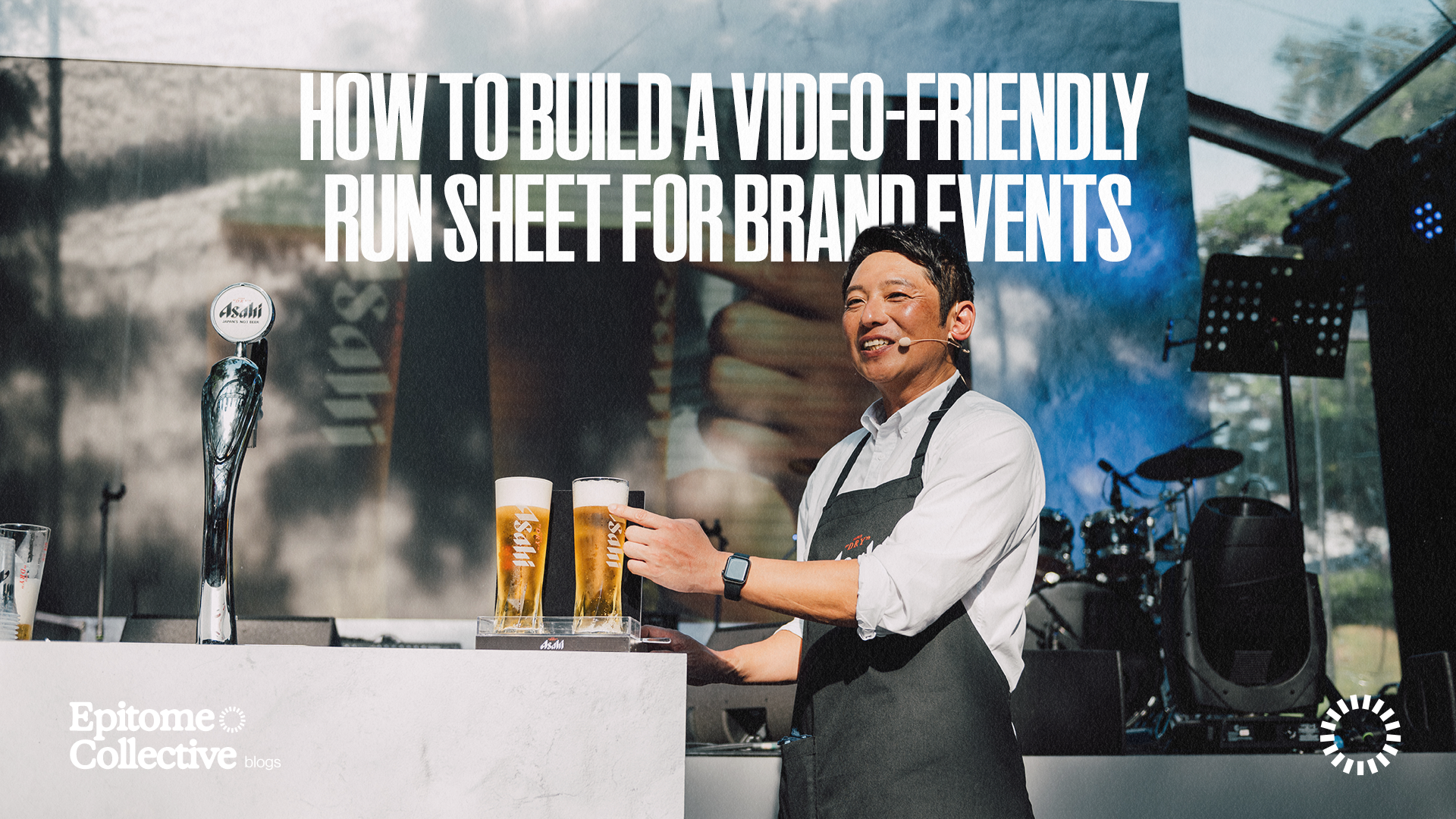Video Production for Brand Events in Singapore

Video Production for Brand Events in Singapore: Turn Live Moments into Lasting Content
The event ends. The doors close. The questions start:
- What content goes live tomorrow?
- What can we show our sponsors?
- How do we keep the momentum going?
Your event might last one night. Your event video can work all year.
In a fast-paced content scene, event video production isn’t just about filming what happened. It’s about turning live moments into powerful content assets that build awareness, drive sales, win sponsorships, and grow your brand long after the event is over.
Whether you’re:
- Launching a product
- Hosting a flagship conference
- Activating a brand pop-up
- Throwing a music festival
Your event is more than a one-off experience. It’s a content goldmine.
This guide will show you how to get the most out of your event by covering:
- What event video production actually involves
- The types of event videos you can create
- Key formats that deliver results
- Real examples of how brands are using event video to fuel their marketing
Because when your event ends, your content strategy should just be getting started.
So what exactly is event video production, and how is it different from simply hiring someone to “cover” your event? Let’s start there.
What Is Event Video Production?
Event video production is more than just recording what happens on the day. It’s about capturing the energy, emotion, and purpose of your event, then turning that footage into content that works for your brand long after the crowd goes home.
Unlike basic event coverage, event video production is a strategic process. It transforms a one-time experience into a long-term content asset. This involves fast thinking during the event, creative storytelling during editing, and smart formatting for every platform your audience uses.
The Four Key Stages of Event Video Production:
- Capture
Real-time filming across multiple areas such as the main stage, crowd interactions, and behind-the-scenes moments. - Story Shaping
Editing decisions that turn scattered clips into a clear, engaging narrative that reflects your brand’s message and emotional tone. - Format Optimisation
Editing content into various lengths and sizes tailored for platforms like Instagram Reels, YouTube, LinkedIn, PR kits, and more. - Distribution Planning
A rollout strategy that spans owned, earned, and paid media, helping your content reach the right people in the right places.
Done well, event video doesn’t just record the experience. It enhances it. It repackages the moment and puts it in front of audiences who couldn’t attend, those considering next year’s event, and the decision-makers who matter most to your business.
Now that we’ve defined what it is, how does event video production differ from traditional, studio-based video work?
How Event Video Differs from Traditional Video Production
At first glance, event video and traditional video production may seem similar. Both involve cameras, crews, and editing. But in reality, they work on very different timelines, with different creative and technical demands.
Traditional video production, such as brand films or commercials, is highly controlled. You build sets, rehearse scenes, and plan every detail before filming. Most of the work happens in pre-production.
Event video production is the opposite. It’s about capturing real moments as they happen. There are no second takes. Lighting is unpredictable. Emotions are raw. You only get one shot to capture it all. That’s where the real skill comes in.
Key Differences at a Glance:

This distinction matters, especially for marketers and brand leads. Your planning, expectations, and content goals need to match the nature of the project.
So now that we understand what event video is and how it differs from studio shoots, let’s explore the types of event videos you can create, and what kinds of events they work best for.
Types of Events That Benefit from Strategic Video
Event video only works if it matches the type of event you're running and the results you're aiming for. Whether you're hosting a music festival or an internal company summit, your goal isn't just to record what happened. It's to create video content that supports real business outcomes, such as raising awareness, growing your community, increasing sales, attracting talent, or telling your brand story.
Here’s a breakdown of five common event types and the best video strategies for each:
Music Festivals & Concerts
What it is:
Large-scale music events built around artist lineups, immersive experiences, and crowd energy. These often span multiple days and attract thousands of people, from fans to influencers and media.
Key features:
- Multiple stages or performances happening in real time
- High-energy crowd interactions and dramatic lighting setups
- Artist and sponsor content needs
- Branded activations across the venue
Why video matters:
These moments are emotional, high-impact, and short-lived. They are perfect for storytelling that builds hype and drives future ticket sales.
Conferences & Summits
What it is:
Professional events focused on thought leadership, networking, and education. Attendees include executives, media, partners, and potential clients.
Key features:
- Keynotes, panels, and workshops
- Structured agendas with networking sessions
- Sponsor booths and branded installations
- Audiences expecting high-value, insightful content
Why video matters:
These events are full of useful content that can fuel marketing and sales efforts for months.
Brand Activations & Pop-Ups
What it is:
Short-term, high-concept brand experiences built to spark interaction and attention. These usually support a campaign, launch, or cultural moment.
Key features:
- Experiential designs and custom environments
- Real-time engagement and product demos
- Influencer or creator involvement
- Tied to a brand moment or product drop
Why video matters:
Activations are designed to be shared. Video extends their reach far beyond the physical space.
Product Launches & Media Events
What it is:
Planned moments to unveil a new product or service. These events are often aimed at press, influencers, and partners.
Key features:
- Staged reveal moments with lighting and AV
- Demo areas and interaction zones
- Interview stations for media and creators
- Brand spokespeople and executives on show
Why video matters:
These events are built for impact. The real value happens after the event when the content rolls out.
Community & Cultural Events
What it is:
Events built around causes, culture, or community engagement. Think CSR activations, heritage festivals, or grassroots campaigns.
Key features:
- Local participation and storytelling
- Authentic, emotional moments
- Informal structures and diverse audiences
- Often tied to brand values or social missions
Why video matters:
These events build trust and long-term brand connection. The right video makes it personal and powerful.
Once you’ve matched your event type to your business goals, the next step is picking the right video formats to maximise impact across platforms.
Key Types of Event Video Content
A common question from marketers is, “What kind of video are we actually making?”
The truth is, most events offer multiple stories. Each story can be told in a different format. Whether you’re building hype, sharing recaps, or creating long-term brand assets, the format you choose directly affects your results.
Here are some of the essential types of event video, what they are, how they work, and when to use them.
Recap or Highlight Films
What it is:
A fast-paced, high-energy video that wraps up your event in under three minutes. It includes key visuals, soundbites, audience reactions, music, and branded moments.
What it looks like:
Tight edits, crowd shots, key speakers, interactions, applause, and dynamic camera movement. All pulled together into a polished summary.
Why it's valuable:
- Ideal for social media, websites, and email campaigns
- Great for post-event PR and future promotion
- Useful in sales or sponsor decks
Best used for:
Conferences, festivals, product launches, brand activations
Branded Mini-Documentaries
What it is:
A story-driven video that explores the deeper meaning of your event. It focuses on why it mattered, not just what happened.
What it looks like:
Interviews, cinematic B-roll, voiceover, layered editing, and emotional music. Built to connect with viewers on a personal level.
Why it's valuable:
- Builds brand trust and emotional connection
- Strong for CSR, community, or mission-driven events
- Great for YouTube, internal communications, or investor content
Best used for:
Community events, cause-based activations, internal summits
Testimonial Captures
What it is:
Short, real interviews with attendees, speakers, or partners. These clips bring human credibility and honest feedback to your event.
What it looks like:
Talking-head videos with branded backgrounds or natural event noise. Often subtitled for mobile viewing.
Why it's valuable:
- Easy to use on LinkedIn, websites, or pitch decks
- Builds trust for future events and sponsors
- Great for use across different stages of a campaign
Best used for:
Conferences, internal events, launches, sponsorship pitches
Short-Form Social Cutdowns
What it is:
Quick, mobile-first videos built for TikTok, Instagram Reels, YouTube Shorts, or Stories. These are designed to grab attention fast.
What it looks like:
Bold captions, vertical framing, synced music, fast edits, and trend-driven content.
Why it's valuable:
- Drives social engagement and reach
- Keeps buzz going after the event
- Perfect for teaser posts or influencer shares
Best used for:
Festivals, pop-ups, press events, daily conference content
Multi-Camera Performance or Session Edits
What it is:
High-quality videos of keynotes, panels, or performances. Shot from multiple angles and edited with intention. These are not raw recordings. They are crafted for replay.
What it looks like:
Wide shots, close-ups, audience cutaways, with clean audio. Slides or on-screen graphics may be added.
Why it's valuable:
- Turns live content into evergreen video assets
- Useful for SEO, training, sales, or thought leadership
- Shows professional execution and value
Best used for:
Conferences, concerts, masterclasses, product showcases
You do not have to choose just one. The most effective event strategies use several formats. For example, start with a recap film, then follow up with social reels, speaker clips, testimonials, or a mini-documentary.
Next, let’s see how a single event can create all these video types, and how to plan for it from the beginning.
From One Event, Many Touch-points
You don’t film an event just to remember it. You film it to repurpose it.
Smart brands treat event video as a content engine. They use footage from a single day to create assets that serve different teams, platforms, and business goals.
With the right planning, one event can give you weeks or even months of usable content.
Here's how one event can break out into multiple deliverables:

Think of your event as a shooting day for your next eight to ten weeks of content. Instead of asking, “What video will we get from this?”, ask, “What campaign can we build from this?”
This model isn’t just for massive festivals or tech expos. Even a one-hour internal event or small-scale product launch can deliver video assets that support:
- Marketing and social media
- Sales and partnerships
- HR and recruitment
- PR and investor relations
When you plan ahead, event content becomes a powerful, multi-use asset that keeps working long after the event ends.
Benefits: Why Event Video Drives Long-Term Value
.jpg)
Event video is more than a creative deliverable. It is a strategic asset that extends your brand’s reach, supports sales, builds trust, and delivers performance across multiple channels.
When done right, one event shoot can power your marketing for weeks or even months.
Here’s how event video continues to deliver value long after the lights go out:
Extends Reach Beyond the Room
Most people won’t attend your event in person. Maybe your venue holds 500 guests, or maybe it was invite-only. Either way, the impact shouldn't stop at the door.
Event video gives your event scale. It turns a live moment into digital content that can reach thousands more across the world.
Examples:
- A conference highlight film generating thousands of LinkedIn impressions
- Vertical clips from a panel discussion repurposed for TikTok and Instagram
- A product reveal sent to global partners who couldn’t attend in person
Why it matters:
You can reach 10 to 100 times more people after the event than you could in person.
Turns Moments Into Evergreen Assets
Your event is packed with value—customer stories, product insights, cultural moments. Without video, those moments disappear. With video, they become evergreen content you can use again and again.
Examples:
- Speaker soundbites turned into a weekly thought leadership series
- Testimonials used on landing pages or in email campaigns
- Product launch clips repurposed for onboarding or training videos
Why it matters:
You’re not just documenting the moment. You’re building a library of content with long-term value.
Builds Brand Equity With Cinematic Proof
A strong event video doesn’t just show what happened. It shows how well it was done. Quality visuals help position your brand as credible, polished, and professional.
Examples:
- A sleek recap video that becomes your company’s sizzle reel
- Behind-the-scenes edits that make your team feel relatable
- Sponsor-branded clips that show value in action
Why it matters:
People trust what they see. A great video gives your brand visual proof of its excellence.
Drives Conversions
Event videos combine storytelling, social proof, and calls to action. That mix helps move viewers from curiosity to commitment.
Examples:
- A testimonial clip used in paid ads to boost sign-ups for the next event
- Product demo highlights embedded in a sales email
- Recap videos featured in investor decks to build excitement and trust
Why it matters:
These videos don’t just look good. They help you close deals, drive upgrades, and support renewals.
Powers Multi-Channel Campaigns
With smart planning, one event can support an entire content calendar. Event footage can serve every part of the business, from social and email to internal communications and sales.
Examples:
- A hero recap video for your homepage and YouTube
- Several short reels for Instagram, TikTok, and Stories
- Testimonial clips used in drip campaigns or pitch decks
- Culture moments shared internally for employer branding
- Thought leadership snippets for executive LinkedIn posts
Why it matters:
You save time, reduce production costs, and show up consistently across all your marketing channels.
In short, event video, when treated as a long-term asset, can deliver compounding returns across awareness, engagement, and sales.
Next, let’s look at a real-world example that shows just how powerful this can be.
Case Study: Tomorrowland
What it is
Tomorrowland’s official aftermovie is a 20-minute supercut made entirely from festival footage. It blends cinematic storytelling with creative post-production techniques like music-synced editing, immersive sound design, stylised grading, time-ramping, and hyperlapse effects.
The result? An emotional, high-energy film that sells not just the event, but the entire culture behind it. The 2012 aftermovie alone has over 187 million views on YouTube and is still being watched today—more than a decade later.
How they did it
- Story-first structure: The video follows an emotional arc—anticipation, lift, euphoria, then afterglow. It feels like a short story, not a random montage.
- On-the-day intent: The team captured moments that clearly belong to the event—arrivals, friendships, rituals, peak crowd reactions, and wides that show scale.
- Magical post-production: Anthem-paced editing, rich crowd ambience, time ramps, and a consistent visual grade all elevate the footage.
- Signature identity: The aftermovie has a distinctive look and sound that stays consistent each year. That recognisable style builds lasting brand memory.
Why it works
- Emotion travels further than explanation. Visual storytelling crosses language and cultural barriers with no subtitles needed.
- It builds a myth, not just a memory. Each aftermovie becomes the definitive memory of the year and a trailer for the next.
- It anchors the whole campaign. One film powers PR, social content, retargeting, and sponsor discussions for months.
- It’s evergreen. New viewers discover and rewatch old editions long after the event, growing brand awareness over time.
Event video is not just “coverage.” When you focus on story and finish with craft, the result is a long-lasting brand asset that drives real outcomes—sign-ups, sponsorships, awareness, and sales.
Key Takeaways: Treat Your Event as a Content Engine
Most events last just one day or night. But if you approach them strategically, the content you create can work for months. It can drive awareness, conversions, sponsorships, renewals, and long-term brand equity.
Here’s what to keep in mind:
- Event video is not just documentation.
It is brand storytelling. Great video captures how your audience felt, not just what happened. - One event can deliver many assets.
From one shoot, you can produce recap films, short-form reels, testimonials, behind-the-scenes content, and more. Each format serves different platforms and business goals. - Plan your story before the cameras roll.
The best content does not happen by accident. Identify your key moments, map out the narrative arc, and shoot with purpose. - Your recap can be the campaign.
As Tomorrowland shows, one well-crafted video can fuel social media, PR, advertising, and sponsor conversations for months. - Think beyond the event itself.
Your video should give your event reach, longevity, and lasting value. A live experience becomes a central brand asset.
When you treat your event like a content launchpad, video becomes more than a recap. It becomes your strategic edge.
.jpg)
If you are ready to turn your next event into a content engine that delivers real results, let’s talk.
Epitome Collective helps brands plan and produce event videos that not only recap but convert, engage, and scale.


